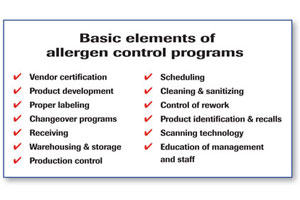During the past six months, there has been a rash of recalls concerning allergens. Most were for products regulated by FDA, but a few were for meat and poultry products, which fall under jurisdiction of USDA. Both imports and domestic products were recalled; small and large companies were involved.

|
The only good thing about these recalls is that almost all included: “No illnesses have been reported to date in association with this product.” However, when reading some of these announcements, I wonder what these processors were thinking. Many of these recalls were initiated because of two or more undeclared allergens, products packaged in the wrong containers or products packed in containers where the company failed to update its packaging after products were reformulated. In one case, an imported product contained a small amount of egg, which the manufacturer thought it did not need to declare since it was at such a low level.
Allergen control is an essential element of processors’ food safety programs in North America, Europe and South America, but some countries in Asia have no food allergen regulations. During my consulting work in China, processors told me that since the Chinese do not have a standard for allergens, they were afraid to go beyond what is mandated, even if they were exporting product. I have heard similar comments in Vietnam and Indonesia. I have also been told no one has food allergies in these countries, even though there are published reports of lethal anaphylaxis.1 Consequently, proper labeling of ingredients used in imported products is essential, and importers need to apply the same or even higher levels of due diligence when it comes to a vendor quality program. They must obtain specifications and formulations, and understand which allergens are used in processing plants. In addition, they must know whether there are “hidden” allergens, such as a minor ingredient in a spice blend, seasoning or sauce.
To be effective, an allergen control program should be addressed in a systematic fashion, literally starting at the receiving dock, where employees have a complete, updated list of all products that contain allergens so they can be flagged upon receipt and stored in designated areas. Production scheduling must take allergens into account to minimize cleanup issues and the potential for cross-contact. Mixing, blending, processing and handling operations must also be set up to minimize the potential for cross-contact. For example, if wheat, soy flour or milk-based ingredients are used in formulations, the areas where the bags of the product are dumped or mixed should be designed with ventilation systems to keep the material from floating around the plant.
Processors also need to verify proper labels are used for each item they pack. Plus, they must update labels when formulations change, and destroy all old labels.
In recent years, Campbell Soup Company has been extremely proactive in labeling. At the 2009 Food Safety Summit, Steve DeMuri of Campbell’s Sacramento plant reported how all the company’s US plants have installed scanners that read both the label and the product code to ensure they match.2 This successful program is now being adopted by Campbell’s locations worldwide.
All processors and distributors, large and small, must have an allergen program to protect their brands and consumers. And management must take an active role in ensuring these programs are followed, with documentation supporting all activities. v
References:
1 Ji, K.; Chen, J.; Li, M.; Liu, Z.; Wang, C.; Zhan, Z.; Wu, X.; and Xia, Q., (2009), “Anaphylactic Shock and Lethal Anaphylaxis Caused by Food Consumption in China,” Trends in Food Science & Technology, 20, pp. 227 – 231.
2 DeMuri, S., (2009), “Use of Vision Systems for Ensuring Safe and High Quality Foods,” Presented at Food Safety Summit, Washington, DC, April 27 – 29, 2009.




